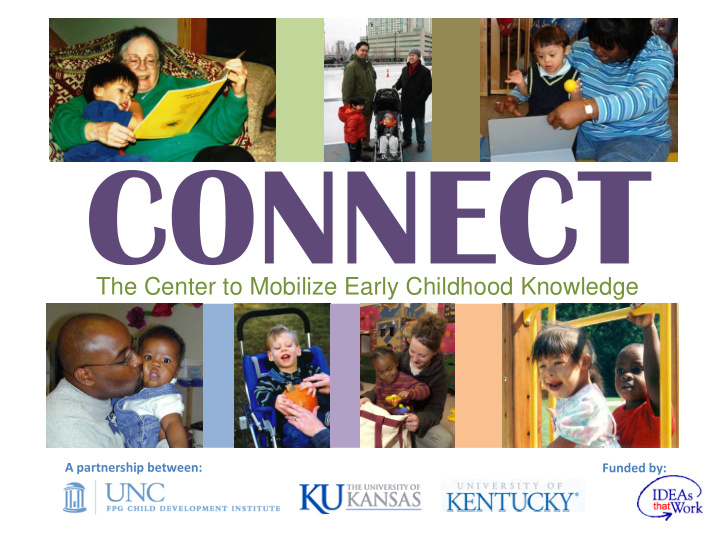



The Center to Mobilize Early Childhood Knowledge A partnership between: Funded by:
The CONNECT Team 1 Heidi Jay Hollingsworth Hargrove Research Admin. Associate Assistant CONNECT
Web ‐ based professional development resources to support inclusion of children with disabilities CONNECT
Session Objectives Participants will: � Become aware of the web ‐ based resources that Connect is developing. � Learn a research ‐ based instructional design sequence to aid in making evidence based decisions. � Identify how to utilize these resources in professional development efforts. CONNECT
Purposes of CONNECT � Web ‐ based PD resources and modules � Focus on young children with disabilities and their families � Help build early childhood practitioners’ abilities to make evidence ‐ based decisions CONNECT
Examples of how modules will be used? � Send learners to the website � Download resources in advance to use in PD opportunities � Display website ‘live’ (using an internet connection) � Others? CONNECT
Upcoming modules � Embedded interventions � Transitions � Family ‐ professional partnerships (focused on communication skills) CONNECT
CONNECT Module Design
What does evidence- based practice (EBP) mean?
identifying specific research ‐ based practices that have been validated through a rigorous review process Odom, Brantlinger, Gersten, Horner, Thompson, & Harris, 2005
A decision- making process that integrates the best available research evidence with family & professional wisdom & values Buysse & Wesley, 2006; Buysse, Wesley, Snyder, & Winton, 2006
Step 1 Step 2 Step 3 Step 4 Step 5 Dilemma Question Evidence Decision Evaluation Research- based practices 5 Step Learning Cycle - Process for Making Evidence-Based Practice Decisions
Module 1 Inclusion: Embedded interventions to promote participation
http://community.fpg.unc.edu/connect CONNECT
Definition and Examples of Embedded Interventions Embedded interventions are specially designed practices that are used to promote children’s engagement, learning, and independence in everyday activities, routines, and transitions in the classroom, home, and community. Examples: • Incorporate a counting activity into snack time • Add books to the dramatic play center to promote concepts of print CONNECT
Step 1: Dilemma Teacher’s Perspective (Jackie) Family’s Perspective (Christine) Step 1: Step 2: Step 3: Step 4: Step 5: > > > > Dilemma Question Evidence Decision Evaluation CONNECT
Turn the Dilemma into an Answerable Question For children like Luke who have significant language delays and limited experience being around other children are embedded interventions effective practices to achieve the following outcomes , that Luke will communicate his wants and needs to adults and peers; and will participate in learning activities with peers, such as story time and circle time? Step 1: Step 2: Step 3: Step 4: Step 5: > > > > > > > > Dilemma Question Evidence Decision Evaluation CONNECT
> Step 1: > Step 2: Step 3: Step 4: > Step 5: > Dilemma Question Evidence Decision Evaluation
Step3: Evidence � Definition & examples of practice � Research � Research Synthesis Points � Policies � Policy Advisory on Inclusion � Consensus statements � DEC / NAEYC Joint Position Statement on Early Childhood Inclusion � Experience ‐ based knowledge � Parents Speak Out CONNECT
Examples of ways to implement embedded interventions � Environmental Modification Altering or arranging the classroom, home, or community environment to promote participation, engagement, and learning of children � Peer Support Enlisting peers to help children reach goals and participate fully and meaningfully in the classroom, home, or community Step 1: Step 2: Step 3: Step 4: Step 5: > > > > Dilemma Question Evidence Decision Evaluation CONNECT
Environmental modification Going to the grocery store Step 1: Step 2: Step 3: Step 4: Step 5: > > > > Dilemma Question Evidence Decision Evaluation CONNECT
Peer Support Step 1: Step 2: Step 3: Step 4: Step 5: > > > > Dilemma Question Evidence Decision Evaluation CONNECT
Combination of Strategies Teacher is holding a voice output device Jack, a 4 ‐ year old with severe motor challenges Step 1: Step 2: Step 3: Step 4: Step 5: > > > > Dilemma Question Evidence Decision Evaluation CONNECT
What examples of embedded interventions did you see? CONNECT
Step 4: Decision Step 4: Decision Evidence � Research � Consensus statements & policies � Experience ‐ based knowledge Decision Integrate Unique Perspectives & Contexts of the Dilemma Step 1: Step 2: Step 3: Step 4: Step 5: > > > > Dilemma Question Evidence Decision Evaluation CONNECT
CONNECT
Step 1: Step 2: Step 3: Step 4: Step 5: > > > > Dilemma Question Evidence Decision Evaluation CONNECT
Step 5: Evaluation Determine if the intervention was implemented? Determine if the intervention was effective? Summarize and use assessment results to determine if the goal(s) are met. > Step 1: > Step 2: > Step 3: Step 4: > Step 5: Dilemma Question Evidence Decision Evaluation CONNECT
How could you envision using a module like the one described here today? http://www.flickr.com/ph otos/barrettelementary/32 6783082/ CONNECT
Q&A CONNECT
Sign up to receive Subscribe to updates on Monthly modules eNews http://community.fpg.unc. edu/news Join the online community CONNECT
http://community.fpg.unc.edu/ Early Childhood Community Pose a Question. Share a Challenge. Contribute Ideas. CONNECT
Recommend
More recommend